An Approach to a Successful and Operational Digital Home
The Digital Home refers to a residence where different devices are connected through a computer network – it is considered a network of consumer electronics, mobile and computer devices that cooperate transparently to simplify usability in the home. The Digital Home facilitates the automatic or semi-automatic control of lighting, doors and windows, and security, surveillance systems and control of home entertainment systems. In this article we will discuss the minimum requirements for a digital home and propose how a digital home should be configured for successful operational use.
Currently the digital home consists of several unconnected subsystems which conform to different standards. For example, a digital house may have cable television, security and telecommunication subsystems that are not connected and are controlled differently.
Standardization is therefore essential for making a multifaceted multi-provider infrastructure work and to connect the various subsystems together to make the digital home viable. Standards are essential for making a multifaceted multi-provider infrastructure work. They can shape the nature of the services and capabilities that are available, as well as how they are implemented.
Standardization will enable interoperability and open standards. Standardization in the digital home network services will ensure the following: interoperability of products serving specific service markets in order to allow diversity and innovation without confusion in the delivery of multimedia services; inter-changeability of products from suppliers serving the same applications in order to promote price competition; interoperability within national environments between different networks comprising the multimedia platforms; interoperability between national networks because multimedia services develop without national boundaries; and seamless end-to-end services provided on a national and international scale, on multiple network platforms, with fully interchangeable product elements.
Broadband technologies will play a key role in the digital home as it is presently providing. Broadband facilitates the provision of information, entertainment, and also a world in which everyone can take part in a borderless and global information society. The digital home requires data intensive multimedia applications such as video communications which, in turn, requires substantial bandwidth, as well as minimal latencies and losses. The average estimated bandwidth is about 65Mbps for a digital home to operate successfully. Each signal or stream requires full access to its required bandwidth at all times in order to maintain acceptable service levels.
Our proposed digital home is expected to be a converged home network where interoperability of various media management and control between different types of multimedia devices and services is applicable. The Quality of Service issues for multimedia services need to be addressed in order to satisfy users’ quality expectation because multimedia applications such as audio and video streams, voice and games are bandwidth and delay sensitive and cannot be overemphasized.

Figure 1 shows the various connected components of our proposed system to make a digital home operational for successful use. It can be seen that all subsystems are connected together using a single network. The Digital Home Gateway is the interface of the digital home network with external broadband services such as PSTN (Public Switch Telephone Network) network. A Centre Connection Point integrates all the various subsystems such as the Home Management System which controls various household appliances, the Entertainment Distribution system which controls entertainment appliances and a Data Communication Services system which controls data communication appliances. Other subsystems can also be plugged into the digital home in the same way. The external broadband services allow the various subsystems to be controlled within or out of the digital home.
We propose that our system supports uni-casting and multi-casting so that seamless end-to-end service provisions on a national and international scale, on multiple network platforms are achieved within the digital home network
Our proposal should support isochronous traffic where time bounded information must be transferred within a specific time frame and there is a low tolerance for delay and loss within the network given the fact that most of the information expected in the network will be real time.
Our proposed system should also have an agnostic platform. Since the digital home is expected to combine different technologies for the various home applications, a single platform is required that will support multiple protocols so that all traffic can be aggregated and administered by a single server.
In summary, currently the digital home consists of various unconnected subsystems which cannot communicate with each other. The digital home requires standardization and better use of bandwidth. In this article we propose a digital home consisting of a converged home broadband network where interoperability of various devices and services can be achieved. Our proposal consists of Digital Home Gateway which is the interface of the digital home network with external broadband services and a Centre Connection Point which integrates all the various subsystems. For our proposal to be successful, the digital home also has to meet various telecommunication requirements.
About the Authors
Dr Apkar Salatian (BSc, PhD) is a lecturer of Information Technology and Communications at the American University of Nigeria, Yola, Nigeria. His research interests are in the areas of time series analysis of high frequency, voluminous and noisy data, telemedicine, data mining, and software engineering.
Engineer Lawrence Oborkhale (BEng, MEng) is a lecturer of Telecommunications at the American University of Nigeria, Yola, Nigeria. His research interests are in the areas of quality of service in telecommunication networks.